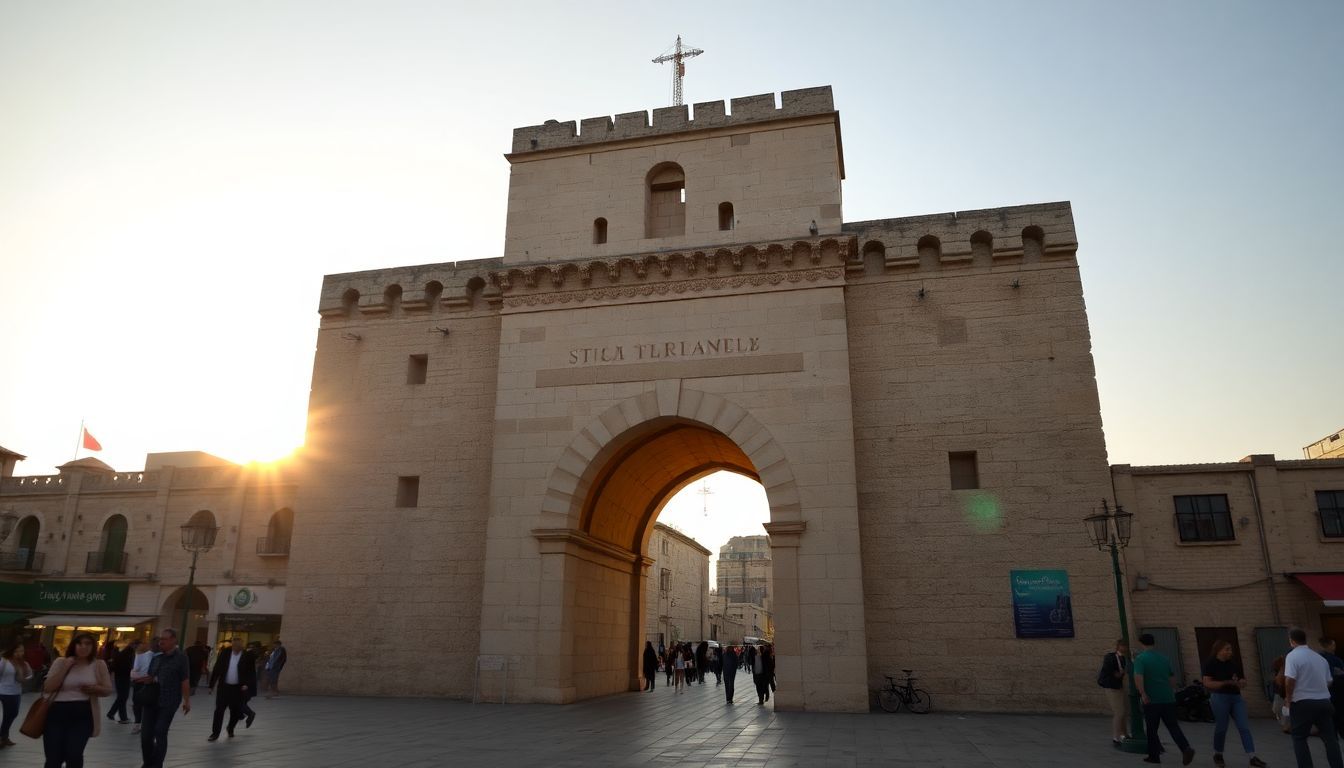Planning a trip to Jerusalem can be overwhelming with so many historical sites to see. One must-visit landmark is Jaffa Gate, a gateway steeped in history dating back to the 16th century.
This article will guide you through its architectural beauty, historical significance, and cultural impact. Discover why Jaffa Gate is more than just an entrance; it’s a journey into the past.
Historical Context of Jaffa Gate

The historical context of Jaffa Gate stems from the Ottoman influence, as it was constructed during Suleiman the Magnificent’s reign, adding to Jerusalem’s architectural heritage. The gate stands as a testament to the city’s rich history and its significance in connecting Jerusalem to neighboring regions.
Ottoman Influence and Construction
Suleiman the Magnificent, an Ottoman Sultan, commanded the erection of Jaffa Gate in the 16th century. This gate soon became an invaluable component of Jerusalem’s city fortifications.
Established in 1538, it rapidly evolved into one of the Old City’s crucial entryways. Its construction and architecture mirrored the majesty and tactical reasoning of Ottoman governance.
Jaffa Gate functioned as more than a corporeal passage, it also connected Jerusalem to essential cities such as Jaffa and Hebron. Being positioned on the western portion of the city, it became a crucial entry point for voyagers and merchants.
As time progressed, this gate experienced numerous historical occurrences, solidifying its trademark as a mighty emblem of cultural lineage in Jerusalem.
Navigating Through Jaffa Gate
Explore the strategic layout and access points of Jaffa Gate, a central entryway into Jerusalem’s Old City, with its historical significance and cultural implications. To delve deeper into this iconic landmark, read our full blog post on the impact of Jaffa Gate in modern Jerusalem.
Access Points and Strategic Layout
Jaffa Gate serves as a key gateway to Jerusalem’s Old City, linking contemporary guests with centuries of history. This gate, established in the 16th century by Suleiman the Magnificent, is situated on the western segment of the city walls.
It’s more than an entry; it’s a journey through time, leading directly to regions filled with cultural and historical importance like the Armenian Quarter and near sacred spots such as the Church of the Holy Sepulchre.
The tactical placement of Jaffa Gate established its historical importance for travelers coming from Jaffa Road destined for Jerusalem. Today, it greets thousands who visit via public transport or by walking, prepared to discover landmarks such as the Western Wall.
Its large space beside the Ottoman gate provides convenient movement for pedestrians and vehicles, making it one of seven primary open gates that guide visitors into Jerusalem’s rich storyline.
Jaffa Gate: Where old routes meet contemporary exploration.
Jaffa Gate as a Cultural Hub
Jaffa Gate stands as a vibrant cultural hub due to its proximity to significant Jerusalem sites, attracting visitors from all over the world. It forms a link between the Armenian Quarter, Church of the Holy Sepulchre and an array of historical landmarks in the Old City of Jerusalem.
Proximity to Key Jerusalem Sites
Stepping out from the historic Jaffa Gate places visitors immediately toward some of Jerusalem’s most cherished sites. The gate itself, a remainder from the 16th century and created under Sultan Suleiman the Magnificent’s rule, operates as more than just an entry; it becomes a portal to history and tradition.
Just a brief walk nearby is the Church of the Holy Sepulchre, a very sacred place in Christianity where many think Jesus was crucified and buried. This closeness renders Jaffa Gate a place of interest and also a handy starting point for those wishing to delve deeply into Jerusalem’s core.
The Western Wall, another notable landmark, is also reachable from Jaffa Gate. It continues today as a symbol of faith and resolve amid Jerusalem’s intricate fusion of cultures and histories.
From this Ottoman-era gate, featuring unique architecture from over 400 years ago, travelers can plunge themselves into accumulated layers of historical accounts that characterize the Holy Land.
Visitors see themselves strolling through alleys that have seen centuries pass, connecting with both ancient eras and current instances within steps from Jaffa Gate’s archways.
Conclusion on the Impact of Jaffa Gate in Modern Jerusalem
Jaffa Gate, a symbol of Jerusalem’s rich history, attracts tourists from around the world. The gate serves as a cultural hub and provides access to key sites in the Old City. Its strategic layout and architectural significance make it an integral part of modern Jerusalem.
Jaffa Gate stands as a testament to the city’s heritage and continues to be a significant landmark in Israel.

